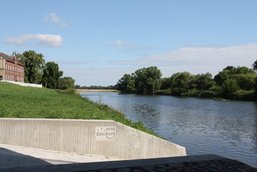The pasture landscape of the Mulde
Mulde, a river landscape of rare dynamics and unique wildlife.
The fish population has recovered, the barbel spread again. Important for biodiversity are the gravel bars. They offer last resort areas to the wolfspider, which is threatened with extinction nationwide. In the spring, the little ringed plover and the rare Sandpiper breed here.
These species of birds need the gravel banks in running waters of the lowlands. In order to protect these species, gravel hunters are prohibited from entering. The steep banks of the Mulde are preferred breeding areas of the strictly protected Bank Swallow and the Kingfisher, which dig their breeding caves. Bird protection is also valid for eurasien hobby, osprey, middle spotted woodpecker, marsh harrier, red and black kite and white stork.
Often the beaver betrays itself by its food marks. Also, the otter has settled again.
The gem of the meadow
An original river landscape is discovered by hikers in the meadow of the Mulden, which begins to open in the Wurzen area. Here, the river has cut wide loops into the low terraces that have emerged in the Ice Age. Between Eilenburg and Bad Düben the river is since 2001 under protection. Here are missing the otherwise typical for the river use weir systems, and fixed banks are rare. The originality and dynamics of the river can be experienced here on 27 kilometers of river.
Between up to four meters high banks, the river is constantly changing. He removes substrates in one place and restores them somewher else. Maintaining this dynamic flow, which can only be experienced in a few places, is an important protection goal. The structurally rich area of the meadow is characterized by numerous old streams, magnificent willow bushes and remnants of former hardwood floodplain forests.
Time window for water hiking
Seasonal restriction:
To protect the species during the breeding season, rest and wintering time, it is only permitted to drive on "Vereinigte Mulde Eilenburg-Bad Düben" from 15 July to 31 October and only with non-motorized watercraft.
Fixed entry and exit points:
Outside the protected area are in Eilenburg and Bad Düben entry and exit options. In the nature reserve there is only at the ferry Gruna an authorized entry and exit point.
Restriction of access for gravel hunters:
It is not allowed to enter the gravel banks and islands. Breeding, residential and sanctuaries of wild animals and their eggs, pupae and larvae did not be damaged or destroyed.



